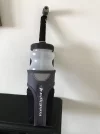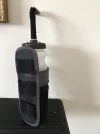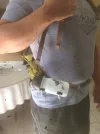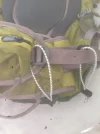I literally just posted this on another thread. Not sure how to link to that post, sorry mods, so I'll just move it to here as this thread is more relevant.
There are a few things to consider IMHO.
-------------------------------------------------------------------------------------------------------------
I was a confirmed bladder user on my first Camino. I loved being able to sip 'at will' and being able to carry plenty of water with me. I go through a lot. I too had a 2 L bladder, and on hot days would throw a couple of extra bottles in the side pouches.
On my next Camino (#3) I won't be carrying a water bladder.
Like the whole debate on poles and footwear, it's a very personal choice. But my reasons are:
- Using the bladder I tended to carry too much water! And the extra weight was noticeable.
- The empty bladder itself is not light.... (165 gms)
- Having said that, a couple of days the bladder ran dry! On really hot days. Thankfully I had a small emergency bottle with me, or came upon a drinks stand in the middle of nowhere. But because the bladder was inside my pack I couldn't easily monitor how full it was...... (one time the bite valve had leaked)
- I'm now training with water bottles, hanging on the front straps of my pack. I use a tube looped around to the other side to drink from. This works really well. I can see exactly how much water I have left. I can use what ever size bottles suit the day. 1.5 - 2L each side if need be! I'm training with 750 ml each side. Pat is using it too and loves the 'system'. She likes to sip as she walks too.
- You'll see on the pic that I use the full length drinking tube. I could cut it very short and save a few gms weight, but I like the idea of added flexibility. I could carry the bottle in a side pouch or even inside my pack if I wanted to.
- Lastly, in the past I have tended to carry too much water (and hence weight). This time I'll make sure to top up my bottles more frequently along the way. Cafes, fonts, etc. But always carrying an 'emergency' bottle of 500 ml or so just in case. That usually also had electrolytes in it.
- I expect most days to carry 2 x 750 ml. Pat carries 2 x 500 ml. But of course that is weather and distance dependant. I think the first time on that 17 km section out of Carrion (with no fonts or villages) I must have carried at least 3 L. I probably used 1.5.........
I really didn't want to give up on my water bladder, using it on #2 as well. But the logic and reasoning of other Forum members got through eventually

Note. The small white clips are Clipsta. As recommended by David. Now called Hipsta I think.
https://www.hipsta.com.au/
The yellow elastic cord is from Amazon. They are quick tie shoes laces.......
The bottle on the right of the picture is actually held in place by the packs 'stow on the go' pole loop.
The one on the left, just with the yellow shock cord.


























